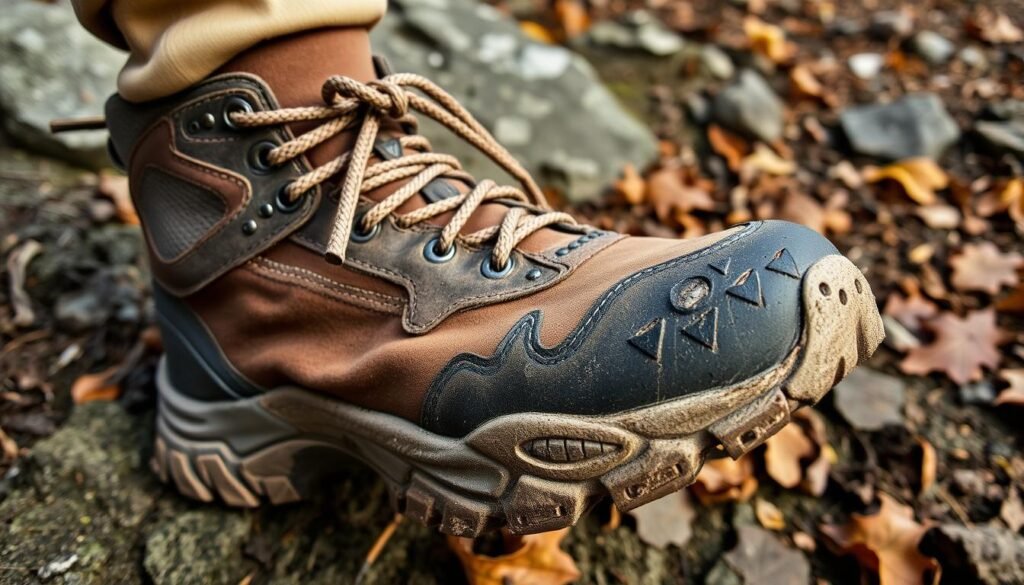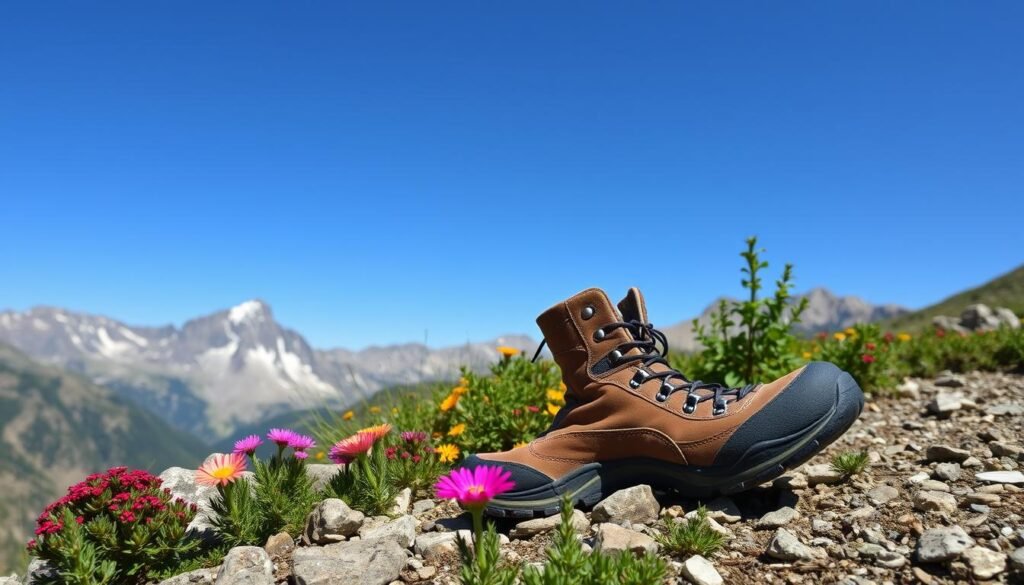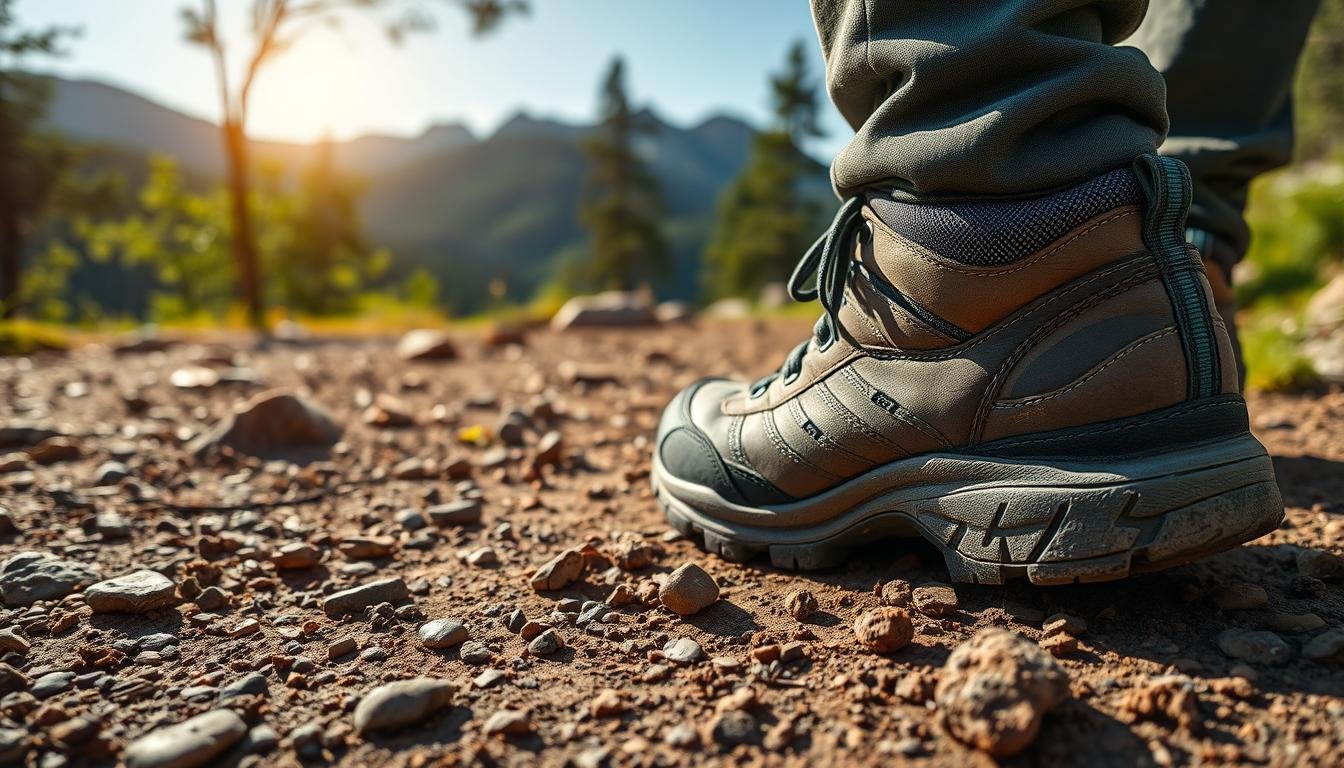Did you know hiking boots should be replaced every 500 to 1,000 miles? This fact shows how important it is to know how far my hiking shoes can go. Whether I’m going on a quick hike or a long weekend adventure, knowing about hiking shoe mileage is key. It helps keep me comfortable and safe on the trails.
As I look into how long hiking shoes last, I’ll talk about how much mileage should I get out of hiking shoes?. I’ll also cover the different types of shoes out there. This will help me make my hiking shoes last longer.
Key Takeaways
- The average replacement mileage for hiking shoes is around 400 to 500 miles.
- Hiking boots can last up to 1,000 miles depending on use and terrain.
- Signs of wear include worn lace loops, sagging ankle support, and cracked midsoles.
- Replacing shoes before developing holes can prevent foot exposure to harm.
- Proper selection of footwear is essential based on the hiking season and conditions.
- Maintenance practices can significantly extend the lifespan of my hiking shoes.
Table of Contents
Hiking Shoe Durability
When we go hiking, it’s key to know how long our shoes will last. Many things affect how durable hiking shoes are. This helps us pick the best shoes for our hikes.
Factors Influencing Durability
How long hiking shoes last depends on a few things. These include the materials, how they’re made, and where we use them. Here are some important factors:
- Material: Leather shoes last longer but are heavier.
- Usage: Hiking often in tough places can wear them down faster.
- Maintenance: Keeping them clean and stored right helps them last longer.
- Type: Different shoes last and protect differently.
Different Types of Hiking Shoes and Their Lifespan
Choosing the right shoe is key to how long it lasts. Here’s a look at some common types:
| Hiking Shoe Type | Averaged Lifespan (miles) | Ideal Use |
|---|---|---|
| Hiking Shoes | 800 – 1,000 | General hiking, good value |
| Trail Runners | 500 | Lightweight comfort, performance |
| Waterproof Hybrids | 500 – 800 | Cold or wet conditions |
| Hiking Boots | 900 – 1200+ | Long-term durability, maximum protection |
Knowing the differences between these shoes can make our hikes better. By picking the right shoes and thinking about durability, we can enjoy our hikes more.
How Much Mileage Should I Get Out of Hiking Shoes?
If you want to know about how many miles my hiking shoes can last is key for better outdoor trips. Most people expect about 800 miles, which means they last 9 to 18 months. But, many things can change this number, making it different for everyone.
Average Mileage Expectations
Different shoes last for different times. Hiking shoes usually last 800 to 1,000 miles. Trail runners, however, might only last 500 to 700 miles. Heavier boots can last over 1,000 miles, especially in tough conditions.
By knowing these numbers, I can pick the right shoes for my hikes.
Variations Based on Hiking Conditions
The trails I walk on affect my shoes’ life. Rocky trails can wear them down faster. But, smooth paths make them last longer.
Carrying heavy packs and hiking often also shortens their life. Keeping my shoes clean and avoiding hard surfaces helps them last longer.
Trail Shoe Lifespan: What to Expect
The life of trail shoes can change a lot. It depends on the brand and how you use them. Knowing how long trail shoes last helps plan for new ones. Some brands are known for lasting longer, which is good to know when buying.
Typical Lifespans for Common Brands
When picking hiking shoes, how long they last is key. For example, Merrell and Salomon shoes can last 600 to 800 miles. But, some like Brooks Cascadia 9s and 10s might only last 100 to 200 miles. This can be a problem for many users.
Pacific Crest Trail hikers say they can get 500 to 1,000 miles out of their shoes with good care. This shows how important it is to choose the right brand for your hiking style.
| Brand | Typical Lifespan (miles) |
|---|---|
| Merrell | 600 – 800 |
| Salomon | 600 – 800 |
| Brooks Cascadia 9/10 | 100 – 200 |
| ASICS | Multiple years (shelf storage) |
When to Replace Your Trail Shoes
It’s important to watch for signs to replace your hiking shoes. Look for less grip and visible wear on the soles. If you see these, it might be time for new shoes.
Checking your shoes after big hikes helps avoid problems. It keeps you safe and comfortable on the trails.
Trekking Footwear Longevity
For those who love hiking, the life of their trekking shoes matters a lot. Knowing how different materials affect their life helps pick the best ones. Taking good care of them makes them last longer on trails.
Understanding Material Impacts on Longevity
What your hiking shoes are made of really matters. Full-grain leather boots last longer than synthetic ones because they’re stronger. Lightweight trail shoes are comfy but might not last a year in tough conditions.
But, high-quality materials in midweight boots can last up to five years. How much they wear down depends on their surface, weight, and where you use them.
Maintenance Tips to Extend Longevity
Keeping your hiking shoes in good shape can make them last longer. Clean them after each trip to get rid of dirt and stuff that wears them down. Dry them right to avoid mold and damage, especially if they get wet.
Using waterproofing treatments helps keep them safe from the weather. Check them often for cracks, worn-out soles, and other damage. This way, you can fix or replace them before they get too bad.
Maximizing Hiking Shoe Mileage
To get the most out of my hiking shoes, I focus on effective care and maintenance. By following proper care tips, my shoes last longer. Simple actions can make my shoes last longer. Also, choosing the right hiking terrain helps keep my shoes in good shape.
Best Practices for Care and Maintenance
Using the right care strategies helps my shoes last longer. Key practices include:
- Using quality hiking socks: This reduces friction and minimizes blisters.
- Avoiding deep water: Keeping my shoes dry extends their life.
- Proper cleaning: Regularly removing mud and debris ensures optimal performance.
- Storage: Keeping shoes in a cool, dry place prevents material degradation.
- Allowing time for drying: Shoes need to dry fully after wet hikes to prevent mold and odor.
Choosing the Right Hiking Terrain
Choosing the right hiking terrain is important for my shoes. I prefer established trails over rugged, uneven terrains. This choice helps my shoes last longer.
- Terrain difficulty: Opt for less challenging paths when possible.
- Surface type: Soft trails reduce impact on soles compared to rocky paths.
- Weather conditions: Avoiding slippery or overly muddy areas can save my shoes from premature damage.
By following these practices, I can make my hiking shoes last longer. This lets me enjoy more miles on the trails without losing comfort or support.
Signs to Replace Hiking Shoes

Knowing when to replace hiking shoes is key for safety and comfort on trails. Some signs show it’s time for a new pair. By checking visually and feeling personally, I make smart choices. This helps avoid discomfort on hikes.
Identifying Wear and Tear on Soles
Looking at my hiking shoes, I check the soles for worn and torn areas. Signs of wear include:
- Worn-out tread patterns, which can compromise grip
- Flat insoles that provide inadequate support
- Visible cracks in the rubber sole
- Physical damage to the shoe structure, such as holes
- Frayed or loosened lacing systems
Knowing When Comfort is Compromised
Discomfort while hiking is a big sign to replace shoes. Discomfort can show as:
- New aches or pains during or after hikes
- Blisters appearing more frequently than usual
- Increased foot fatigue on trails that were previously comfortable
- Feeling of instability or lack of support, especially in the ankle areas
Checking these signs keeps me supported and comfortable. By watching for wear and discomfort, I improve my hiking.
Hiking Shoe Tread Wear Indicators
It’s key to know about hiking shoe tread wear indicators for safety and performance. The tread patterns help with grip on different surfaces. Spotting worn tread is crucial to prevent accidents and injuries.
The tread depth affects how well the shoes grip. This is very important on slippery or uneven ground.
Understanding Tread Patterns
Every hiking shoe has its own tread patterns for different terrains. By looking at my shoes, I can see if they’re still good. If the tread looks smooth or worn, it’s time for new shoes.
Knowing about tread patterns helps me decide when to replace my shoes. This keeps my hikes safe and fun.
Measuring Tread Depth
Checking tread depth is easy. I use a ruler or a special gauge. If it’s less than 1/16th of an inch, it’s time for new shoes.
Checking this regularly keeps my shoes in top shape. It makes my hikes safe and comfy.
Getting the Most Out of Hiking Boots

Choosing the right hiking footwear is key for comfort and performance. I think about my needs and the terrain when deciding between shoes and boots. Hiking shoes are great for easy hikes or warm weather. Boots offer more support and protection, especially on tough trails.
Comparing Options: Hiking Shoes vs. Boots
When choosing, I consider several factors:
- Weight: Shoes are lighter, boots offer more support.
- Traction: Boots have better grip, good for slippery paths.
- Durability: Quality boots last longer, especially from top brands.
- Fit: Trying different sizes and styles is important for comfort.
When to Invest in Higher-End Models
Investing in good hiking footwear makes hikes better. Brands like Vasque and Merrell focus on durability and comfort. These boots can last over a thousand miles with care.
Knowing when to replace boots is important. For example:
| Type of Footwear | Average Lifespan (Miles) |
|---|---|
| Merrell Moab Ventilators | 300+ |
| Tevas Shoes | 1000+ |
| Solomon and Montrail Shoes | 300 |
| Vasque Boots | 450-500 |
| Vasque Switchback GTX | At least 1000 |
| EVA Midsoles (Typical) | 400 |
Getting the most from hiking boots means finding a balance. Comfort, support, and lasting quality depend on your hiking style and the terrain. The right pair makes a big difference.
Conclusion
Knowing how much mileage my hiking shoes can handle is key. Quality boots and trail shoes last between 500 to 1000 miles. But, my weight and how often I hike affect their life.
Keeping my shoes clean and dry after each trip helps a lot. The brand and type of shoe also matter a lot. I should compare different shoes to find the best fit for me.
By watching for wear signs and taking good care of my shoes, I can enjoy many adventures. Whether I choose expensive shoes or have several pairs, I’ll hike better and safer.





